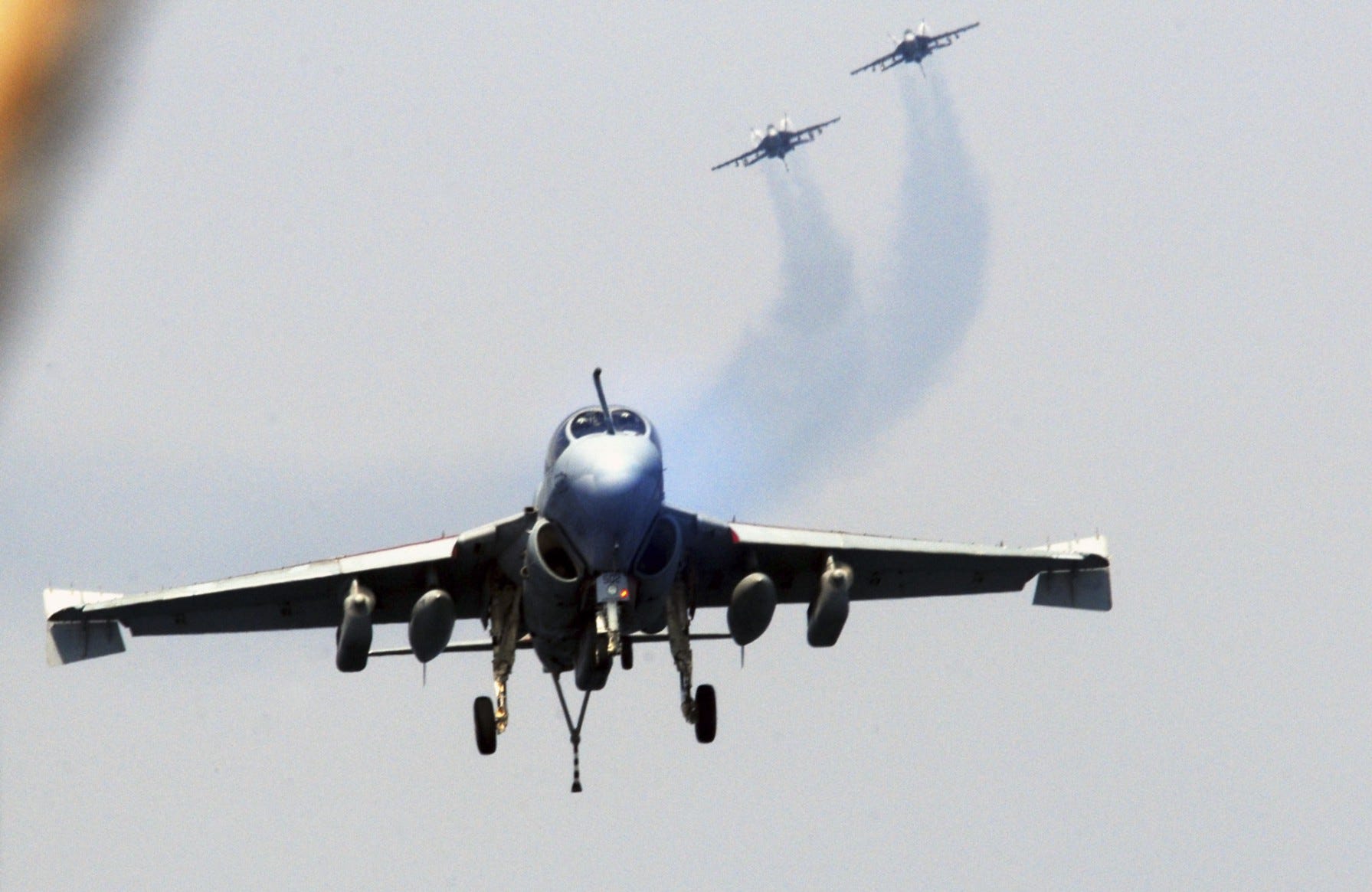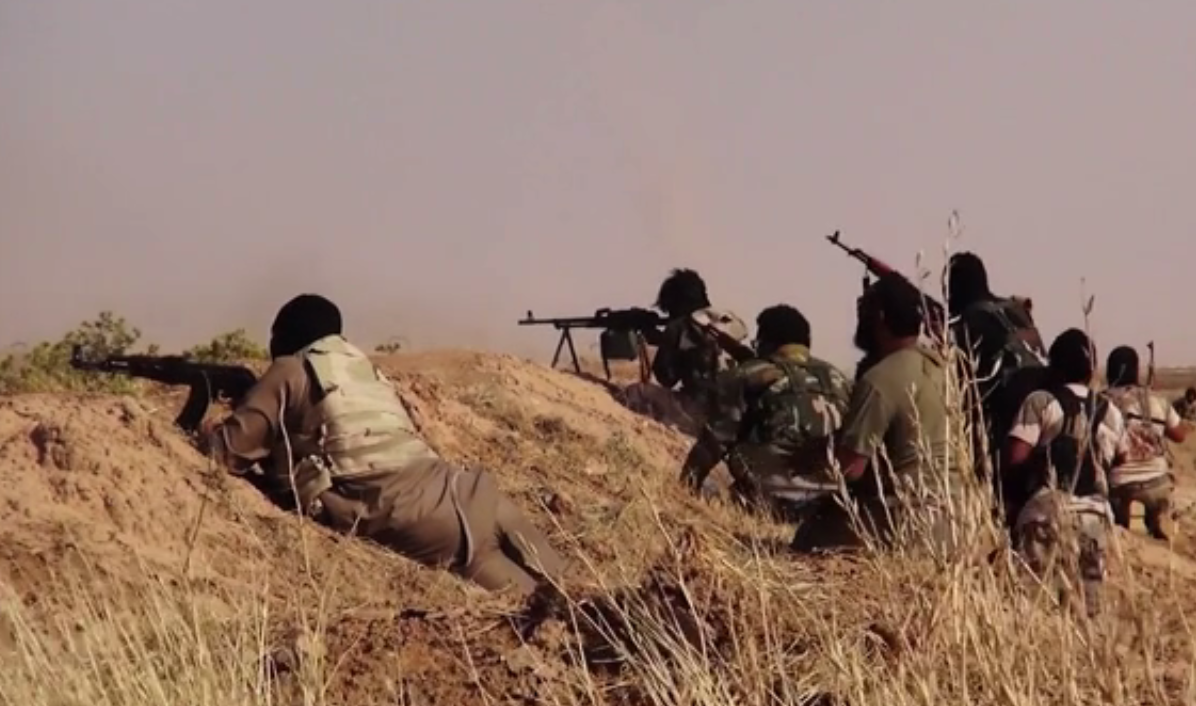American and allied forces target Islamic State
Just before four o’clock in the morning on Sept 23, jet fighters streaked overhead and bombs rained down down on Al Raqqa, the “capital” of the Islamic State militant group in Syria.
The roar of engines and sharp cracks of explosions, audible in the amateur video below, marked the beginning of a major offensive by American and allied warplanes and ships—and, it seems, the U.S. F-22 stealth fighter’s combat debut.
Thirty minutes later, the Pentagon announced the offensive.
Let’s make one thing clear. The United States and its allies are now at war in Syria. The raids on troops, depots and command facilities come as more than 130,000 Syrian Kurdst have fled toward Turkey to escape Islamic State.
The U.S. nearly bombed Syria last year, but Pres. Barack Obama called off the attack at the last minute. The irony is that had the U.S. bombed Syria at the time, the target would have been Syrian president Bashar Al Assad’s brutal regime.
Now America is bombing Islamic State, which is fighting against Al Assad and also against pretty much everyone else in the region.
To complicate matters, Iran is helping out Kurdish troops—America’s allies—against Islamic State in Iraq. But Iran is also arming and training Al Assad’s forces.
The result is that the U.S. wants to destroy Islamic State and avoid targeting the Syrian regime in the process. But the White House is alsoopposed to the Syrian regime and is preparing to back a coalition of rebel groups inside the country which can fight both the Islamic State and the Syrian army.
It’s a mess. But at least the Americans finally got to put their pricey F-22s to use.
Air and sea bombardment
In the Persian Gulf and Red Sea, American warplanes launched from the decks of the aircraft carrier USS George H.W. Bush and the assault ships USS Bataan and USS Makin Island.
Escorting warships fired long-range Tomahawk cruise missiles.
American warplanes in the region include F-22s, F-15Es and F-16 fighters and B-1B bombers, plus KC-135 aerial tankers and RC-135 spy planes. Many of the U.S. planes fly from Al Dhafra air base in the United Arab Emirates and Qatar’s Al Udeid airfield.
Predator drones—and possibly the larger Reaper drones, too—reportedly operate from an airfield in Kuwait. The Pentagon announced it was also setting up an air base in Erbil, in Iraqi Kurdistan. Air Force A-10 tank-killer jets are on their way to a base in the Middle East, but we don’t know exactly where.
At Al Udeid, U.S. Central Command also has a high-tech control room called a Combined Air Operations Center—basically, a warehouse packed with $60 million worth of digital maps, radios and super-fast Internet connections, which military officers use to keep track of warplanes and direct them toward their targets.
Assuming the military bases its Syria battle plan on the weeks-old air campaign targeting Islamic State militants in Iraq, the marauding warplanes include Air Force jets flying from land, as well as Navy and Marine planes launching from the three flattops Bush, Bataan and Makin Island.
All together, American planes—and a handful of French Rafale jets—have struck militants in Iraq around 200 times since early August.
Bush’s air wing for these missions includes some four dozen F/A-18s fighters—some are the latest F/A-18E/F models—plus EA-6B jamming planes and E-2 radar aircraft. Bataan and Makin Island each carry six Marine Harrier jump jets, which began flying surveillance missions over Iraq in August before finally dropping bombs in September.
But the attackers could also include Air Force B-2 and B-52 bombers staging directly from their home bases in the U.S. B-2s famously flew halfway around the world to pulverize Libyan targets during the NATO air campaign targeting that country back in 2011.
USA Today claimed that jets belonging to Bahrain, Qatar, Saudi Arabia and the UAE also took part in the attacks.
 An EA-6B landing on Bush. Navy photo
An EA-6B landing on Bush. Navy photo
Clearing the way
In any event, the preparations for the raids clearly began long before the early morning hours of Sept. 23. Activists in Al Raqqa spotted a Predator drone overhead in early September. Drones can use their video cameras and ground-mapping radars can scout out targets for manned planes.
Flying patterns along Syria’s borders, the four-engine RC-135 spy planescould have hoovered up electronic signals in order to map Islamic State’s positions—not to mention the positions of regime air defenses and Iranian forces assisting the Syrians.
We know the Air Force has occasionally stationed RQ-170 stealth drones at Al Dhafra in the UAE, but it’s not clear whether the radar-evading robots have spied on Islamists in Syria.
The Navy’s EA-6B electronic warfare jets might also have played an important preparatory role. The aged warplanes haul around ALQ-99 jamming pods that can scramble enemy air-defense radars.
But since Islamic State probably doesn’t possess much in the way of radars and surface-to-air weapons, the EA-6Bs probably switched to jamming radios and cell phones, instead. “A lot of what we do is com-centric, and really we have been focusing on denying the enemy the ‘kill chain’ communications,” a Prowler pilot told Combat Aircraft.
With targets mapped out and enemy communications on the fritz, the strike planes probably came next, infiltrating Syrian air space in the dead of night. The fighters and bombers likely scanned with their own pod-mounted infrared cameras before lobbing laser- or satellite-guided bombs.
The Wall Street Journal reported that F-22s participated in the Sept. 23 raids. If the F-22s indeed played a role, the supersonic stealth fighters probably escorted the other attackers—perhaps to protect them from Syrian warplanes. There is always a danger the Syrian regime could try to intervene in the U.S.-led campaign.
The apparent escort missions represent the F-22’s combat debut, eight years after the sophisticated jet entered front-line service.
 Islamic State fighters in combat in June 2014. Islamic State propaganda video capture
Islamic State fighters in combat in June 2014. Islamic State propaganda video capture
Islamic State, entrenched
Bombing Islamic State in Syria greatly expands the scale of a war that began this summer for America, when the Pentagon deployed air power and advisers to help hold back militant forces in northern Iraq.
The Islamists still control a huge swathe of northern Iraq centered on the city of Mosul and snaking along rivers the jihadist group uses to transport fighters and supplies.
But now U.S. warplanes are in action above Islamic State territory in northern and eastern Syria, which extends like a belt from the Iraqi border up the Euphrates River, through Al Raqqa and to the Turkish border.
Here Islamic State possesses a deadly ground force numbering thousands of men. Syria is the militants’ main bastion.
But it’s a poorly defended one—from air attack, at least. The militants’ anti-aircraft weapons are a rusty mix of heavy machine guns and shoulder-fired missile launchers.
In late August, Islamic State fighters overran the Tabqa air base in Al Raqqa province, capturing more missiles and several MiG-21 fighters. But the MiG-21s wouldn’t stand a chance against U.S. warplanes even if Islamic State could launch the planes.
The main threat to Washington’s jet fighters is Al Assad’s missiles. Provided regime air defenses don’t shoot back, the U.S. should have free reign to strike Islamic State targets in Syria.
But if they do shoot back, America will become involved in a war against two enemies … who are also at war with each other.
Predictably, the Pentagon isn’t saying more than the bare minimum about the melee. The media, not the military, revealed the F-22s’ involvement in the strikes.
“Given that these operations are ongoing,” Kirby said, “we are not in a position to provide additional details at this time.”

No comments:
Post a Comment